Travel and Culture: Alaska Part 4— Some other highlights from my time in Juneau
By Cornelia Seckel
arttimesjournal July 4, 2017
This was such a fabulous trip and I've a lot to write about including: Juneau history, arts and peoples, ArtWalk and Artists in Juneau, Native Alaskans, Artists in Haines, Arts and Culture in Haines accompanied by some gorgeous videos and pictures. So come back to read this continuing travelogue. Much of my travels can be found on my blog and selected images on instagram
Part 1
Part 2
Part 3
 Zuill Bailey, cello (artistic director of the Sitka Music Festival); Scott Rawls, viola; and Kurk Nikkannen, violin played at An Evening of Beethoven at the Juneau Arts and Humanities Council. |
Each year The Juneau Arts and Humanities Council holds a benefit concert for the upcoming Juneau Jazz and Classics series. Zuill Bailey, cello (artistic director of the Sitka Music Festival); Scott Rawls, viola; and Kurk Nikkannen, violin played at An Evening of Beethoven. It was an excellent concert, the musicians enjoying each other and the music and the appreciative audience of over 300 that people filled the auditorium. I was pleased to see so many young people amongst the seniors. There is an abundance of Art, Music and Theater in Juneau, especially after tourist season. In speaking with the musicians after the concert I learned that several have played in music festivals throughout the US including the Maverick Concerts in Woodstock, NY, the oldest continuing summer concert series in the US.
How could I leave Juneau without visiting a gold mine? I made arrangements to visit the AJ (Alaska Juneau) Gastineau mine.
Constructed in 1913, the Alaska Gastineau Mill was a revolutionary plant that introduced new technologies to the mining industry. This underground mine operated from 1914-1944 producing 90 million tons of gold-bearing ore, and was one of the largest mines in the world at the time.
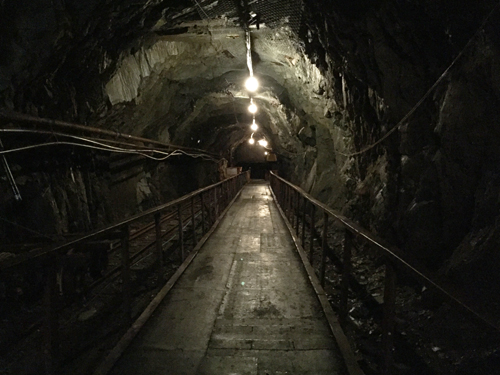 360 foot tunnel into the mine |
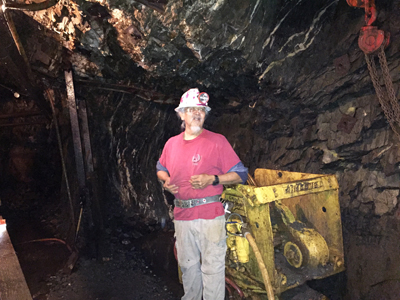 our guide thru the mine |
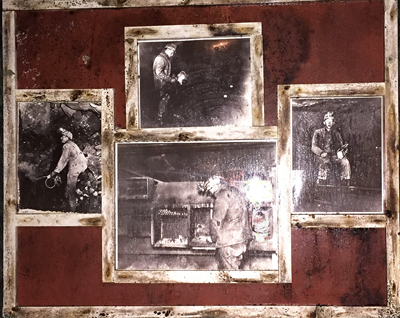 miners |
Gleaned from a variety of internet sources:
• The two most common methods of mining are surface and underground mining. The method is determined mainly by the characteristics of the mineral deposit and the limits imposed by safety, technology, environmental and economical concerns.
• The first step in the production stage is recovering the minerals. This is the process of extracting the ore from rock using a variety of tools and machinery.
• The second step is processing. The recovered minerals are processed through huge crushers or mills to separate commercially valuable minerals from their ores.
• Once processed, the ore is then transported to smelting facilities.
• The final step in production is smelting. This process involves melting the concentrate in a furnace to extract the metal from its ore. The ore is then poured into moulds, producing bars of bullion, which are then ready for sale.
The City and Borough of Juneau control the land, and is considering re-opening the mine. In the 1930's the AJ mine employed around 1000 people and produced 12,000 tons of ore per day and operated 24 hours a day, 363 days a year. The mine continued operation until it was closed by federal order in 1944 since gold was considered non-essential for the war effort. In total, around 90 million tons of ore were mined, producing millions of ounces of gold.
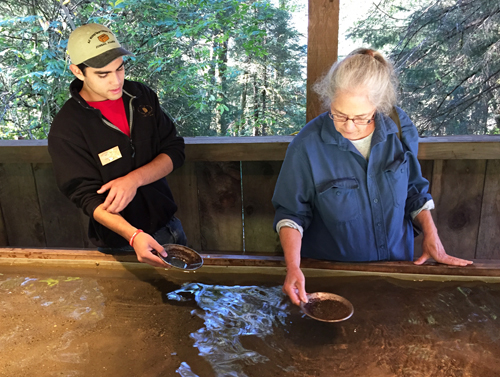 Cornelia Seckel being instructed on the art of panning for gold |
Our guide John, an experienced miner, explained the different mining methods before bringing us into the mine. We were given hard hats before proceeding along a boardwalk into the 360-foot-long tunnel. Once inside we learned and saw demonstrations of hard rock mining techniques. John spoke to us about the lifestyle of miners.
Over the years there have been major safety improvements for miners and the Kensington mine 45 miles north of Juneau is still in operation. In 2016, approximately 626,797 tons of ore were mined resulting in approximately 127,118 ounces of gold. At the end of 2016, Coeur Alaska employed 331 people. Currently, they employ 343 people and are ramping up to 356 people.
When we returned to the mill site we were able to pan for gold from the tailings of the mine, something I remember doing as a kid while on a family cross country trip. I was able to find a dozen small flakes that are now in a small glass container in my office and reminds me of the excellent time and experiences I had in Alaska.
Back into town I met up with Harry Vannatta and Stephanie Nicosia, a delightful couple recently moved to Juneau. They met online a few years ago, fell in love with Alaska and moved from LA. At first Harry, trained in culinary arts, made crepes but found that selling preserves was more lucrative and logistically sound.
 Harry Vannatta and Stephanie Nicosia outside their kiosk for Harry’s Wild Berry Preserves |
They formed the 1st cottage industry in Juneau and thus Harry’s Wild Berry Preserves began. After harvesting the berries last year Harry and Stephanie made over 400 jars of jams and within the first month sold over 2/3 of them. They sold their preserves (Salmon Berry, Blueberry and Huckelberry) on the docks in downtown Juneau. I recently heard from both Harry and Stephanie. They are currently in full operation manufacturing their delicious preserves and accumulating a large stock for future sales! Harry's Wild Berry Preserves has set a tenacious goal to reach mass market in a matter of just a couple short years. Aside from creating a soon-to-launch Kickstarter campaign to reach the mass market for financing they have also entered the business in the contest (Path To Prosperity) in Southeast Alaska to possibly win $25,000 in funding! This year Path To Prosparity is looking for a local food business that utilizes wild resources so they believe they have a great chance of winning the funding. Last season Harry's Wild Berry Preserves was happy to sell out of their delectable, all natural products on the docks in Juneau and they are looking forward to exponential future growth! Send Harry an email at harrylvannatta@gmail.com and he can keep you up to date.
 Entryway to Galleries at the Alaska State Museum |
The new State museum had just re-opened in June 2016 after major renovations and I could have spent a week exploring. I was fortunate that the Registrar Andrew Washburn was filling in at the reception desk. Andrew told me that the Museum is known as a general museum for the people of Alaska. Collections are from natural history, ethnology, history, archeology and art. The strength of the collection is ethnology and the objects related to native people of Alaska. He said that the museum shows the resilience of the native Alaskan peoples to the colonialism which continues to happen and exhibits carefully articulate that idea. What an abundance of items on display both contemporary and old — and that was only 3% of the collection!
Established in 1900, the Museum collects, exhibits, and interprets the human and natural history of Alaska and features extensive ethnographic exhibits on the cultures of Alaska's Native people. There are 3 rotating exhibits; 2 from the permanent collection and one contemporary exhibit. The Rasmuson Foundation provides funds to purchase art from Alaskan Artists currently living in the state.
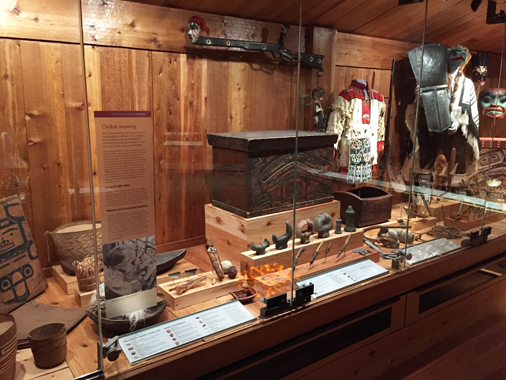 Display- Native Alaskan Display- Native Alaskan |
 Long view of gallery |
|
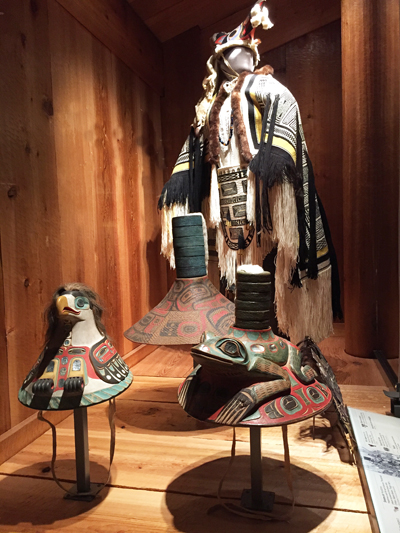 Display of Tlinget ceremonial hat and robe |
 carved ivory 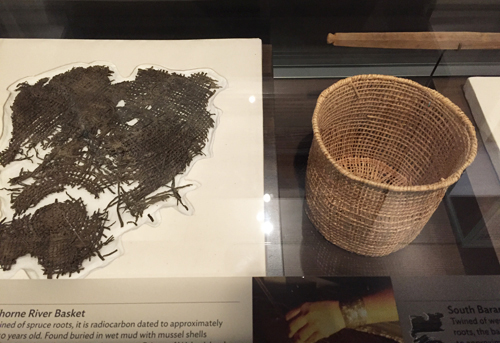 Thorne River basket |
The history of the peoples of Alaska began over 14,500 years ago with the migration across the Bering Bridge. Native cultures had sophisticated systems including legal, educational, kinship, social order, health and complex language and profitable trade systems. Vitus Bering (1681–1741) was a Danish explorer for the Russians and in 1741 the first European to reach Alaska. Their arrival was catastrophic for native Aluet peoples who were exposed to foreign diseases. By 1780’s British and American traders arrived. In 1867 the US bought Alaska from Russia for 7.2 million dollars. In 1958 Alaska became the 49th state.
Take a look at my blog for some videos of the Mine Tour and Museum
Check back as the adventure continues as Donna and I head up along the inside passage to Sagway and Haines.
